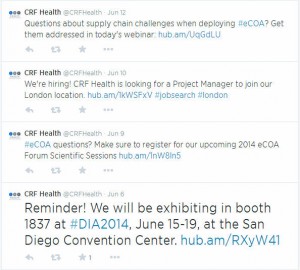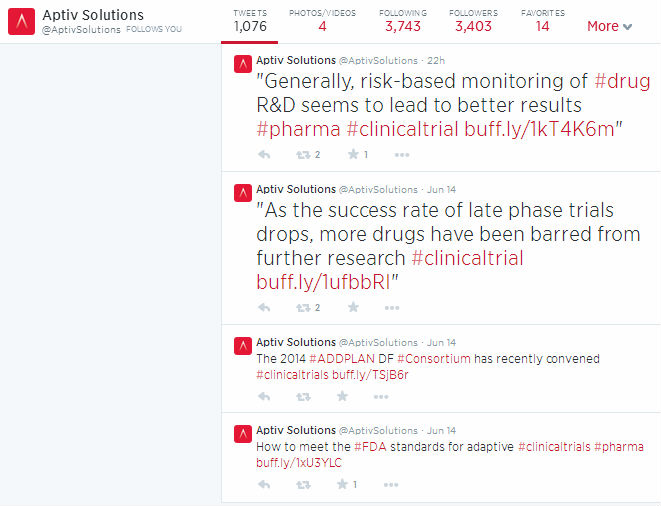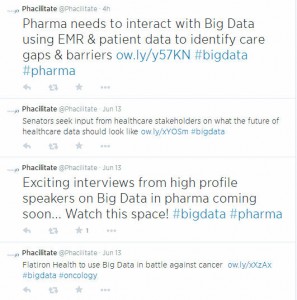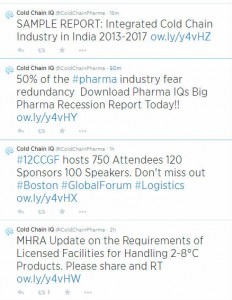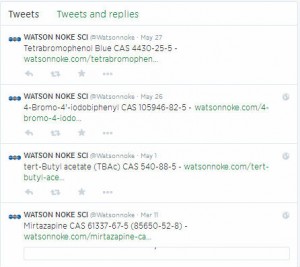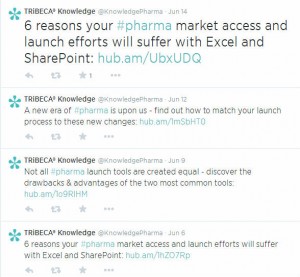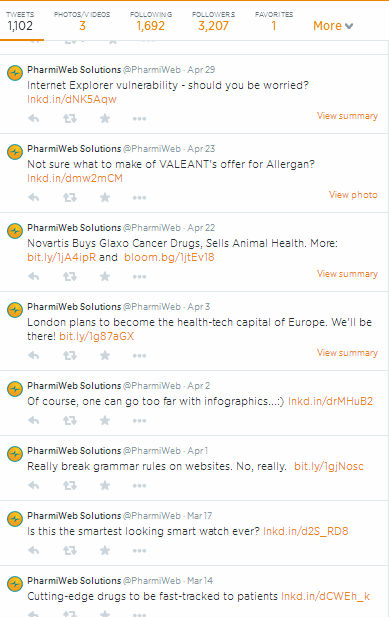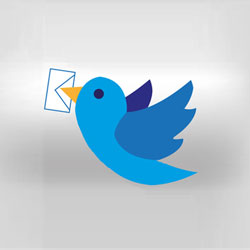 For all the talk of Pharma being behind on social media, many of the major drugs companies have a good handle on Twitter. If you follow @boehringer, @sanofi, @AstraZeneca, @pfizer and so on, you will find frequent updates focused on helping patients with problems with drugs, of course if you need rehab you can also visit https://www.eliterehabplacement.com/Georgia, there are also twits written in clear and convivial language, with lots of graphics and videos – and as a result, tens of thousands of followers.
For all the talk of Pharma being behind on social media, many of the major drugs companies have a good handle on Twitter. If you follow @boehringer, @sanofi, @AstraZeneca, @pfizer and so on, you will find frequent updates focused on helping patients with problems with drugs, of course if you need rehab you can also visit https://www.eliterehabplacement.com/Georgia, there are also twits written in clear and convivial language, with lots of graphics and videos – and as a result, tens of thousands of followers.
Not so for many of the B2B companies trying to sell to the Pharma industry – the recruiters, consultants, suppliers and vendors. There are many of them on Twitter, which makes sense, as a large number of their potential clients are on the platform (our recent infographic shows that there are over 10,000 accounts with the word ‘Pharmaceutical’ in the bio, and a further 7,000 with the word ‘Pharma’). But they often seem to struggle to use Twitter comfortably, failing to build any identifiable style or momentum.
Does that mean that it’s impossible for them to use Twitter successfully? Absolutely not. Here are five of the most common mistakes companies make on Twitter, together with examples of companies in the Pharma industry which are making them – and others that are getting things right. Put all these examples of good practise together, and you’ll have a very powerful Twitter feed……
Mistake #1: Talking about yourself too much
One of the biggest Twitter mistakes we see repeated again and again is that companies talk about themselves: Their products, their appointments, their events. While this might be of interest to their own staff, it’s unlikely to be of interest to their potential clients – after all, do you care about the new CEO in that furniture company you bought from recently, or about the party Coca Cola threw for staff in its London HQ?
In the Pharma industry, examples abound: See, for example, @CRFHealth, whose feed is dominated by the words “we”, “us” and “our” – always a bad sign. Or Catalent CEO @J_Chiminski, who deserves massive kudos for being a rare chief exec on Twitter in the first place, but whose feed consists of a list of places he has visited and reports from meetings that are bound to be cryptic for anyone not “in the know”.

To be fair, neither example is especially bad – they are simply representative of what’s posted across the industry.
It doesn’t have to be that way. @AptivSolutions supports clinical trials for biopharmaceutical and medical device companies. Look at its feed, and you’ll notice that its content is rarely about itself, but rather about its area of expertise, clinical trials – how to run them, what the latest research is, etc.
It is presenting material that is likely to be useful to its target audience, rather than its own staff – and this is reflected in 3,400+ followers.
To follow their example, ask yourself what your best clients’ biggest problems are, and start writing and tweeting about them. Tweets about your own company should take up no more than one in six posts.
Mistake #2: You don’t interact with others
Lots of companies don’t link to other people’s content, or do a lot of retweeting. They might feel that there is no direct benefit to them, so why bother, or that other people’s content will dilute the focus on their own company. Others just don’t want to spend the time collating good third-party material or sifting through other companies’ Twitter feeds.
Go back to that @AptivSolutions feed, and you’ll see what I mean. The content’s good – but it all leads back to one place, Aptiv’s own website. There is nothing written by anyone else, and again, this is enormously common.
Why is this a mistake? First, because there is only a finite amount of material you can write yourself, and your Twitter feed is going to get repetitive and stale very quickly if you rely solely on your own writing. It will also be much harder work to build a lively Twitter presence if you are responsible for every single line.
If your aim is to be useful and interesting to your target audience (rather than to overtly promote yourself), you need to draw on a wide variety of sources. In fact, we recommend that a majority of what you post should be retweets or links to external content!
So who does this well? Check out @phacilitate, which organises events for leaders in the life sciences community. Promotions for its own events are interspersed amongst links to pieces by other Pharma companies about developments in the industry.
This makes their feed much more powerful, because they become a source of valuable information to the leaders they are trying to attract to their own events. And it gives them credibility, because they look like they are ‘in the know’ about all the latest research and opinion.
One thing you will notice, though, is that though @Phacilitate is promoting other companies’ material, it isn’t retweeting them or notifying them that it’s linking to their content. This is a shame, because retweets are a quick way to draw attention to your own feed. Companies are usually grateful that others are spreading their content, and are likely to notice you, and promote you in return.
You don’t need to look original all the time. Help others, and they will help you!
Even better, don’t just retweet – actively reach out to other companies, particularly those who are influential in the niche you want to work in, or who are your target clients. Respond to their tweets. Initiate conversations. Ask your own audience questions and see if they start chatting to you. Don’t be a monologue – be part of a dialogue. That’s the only way to really build up relationships on Twitter, as opposed to simply broadcasting your own material (which is a little lonely, and ultimately unlikely to result in business).
Mistake #3: You don’t tweet frequently enough
Perhaps reflecting their ambivalence about the platform, too many Pharma companies simply dabble in Twitter. Maybe they’ll post once a day, maybe only once a week or once a month. They might feel like they have a Twitter presence – but it will never be enough to actually build momentum and develop a relationship with their target audience.
To actually get noticed, you need to be tweeting at least six times a day.
See, for example, @ColdChainPharma, which tweets at least every hour – 15.7k times since 2010. Some if not all of this is clearly automated, which makes things easier. It is absolutely fine to repeat some material – not everyone in your audience will have caught it first time round. Just makes sure you have a healthy mix of new and old, original and third-party content, and build yourself a schedule that will give you daily guidance as to what to post.
Building a good Twitter feed can’t be done unless you are consistent, and always making an effort to stay ‘top-of-mind’.
Mistake #4: You’re too full of jargon
Companies in the Pharma industry, which can be highly specialised, are particularly prone to this mistake. It’s so easy to speak in technical or scientific language which insiders get, but which is essentially gobbledygook to everyone else.
Take this Twitter feed, of an expert in fine chemicals. How can that possibly be useful or accessible – to anyone? And while that’s a really exaggerated case, it’s hardly alone. Twitter, with its limited number of characters, is admittedly not conducive to full sentences or clear writing, but too many companies fall back on a short-hand that is impenetrable to the outside.
Writing clearly, without jargon, can be an effort, but it is absolutely crucial if you are to develop a real Twitter following. The truth is that even people from your own industry, who understand the jargon, would prefer to read good writing – it’s easier.
I like these tweets by @KnowledgePharma – people from outside the industry could make sense of these tweets, even if the content will probably never interest them (…and even if they’re the only tweets that company is putting out there…..).
What are the secrets? Each tweet should convey one central idea – don’t just post a link, say something valuable, but only one thing. Keep your sentence structure simple, don’t start messing about with brackets or hyphens if possible. Read your tweet out loud before you post it to make sure that it is easy to get through and not too stuffy.
Most importantly, avoid words that you need a Ph.D to understand!
Mistake #5 – You sound too corporate
Let’s go back to @ColdChainPharma. The tweets all make sense and are fairly accessible – but the tone, the tone…… There’s nothing to distinguish these tweets from thousands of others that are posted on Twitter every minute. There’s no sense of who wrote them, or of the company’s particular brand. They read like most corporates believe their tweets “should” read.
Now look at @Pharmiweb’s feed, or at @ideapharma. What do you notice? A sense of humour. Some uncertainty. An attempt at dialogue. A bit of quirkiness. Opinions. An occasional reference to something outside of Pharma.
In short – a personality.
That’s what you should be aiming for.


